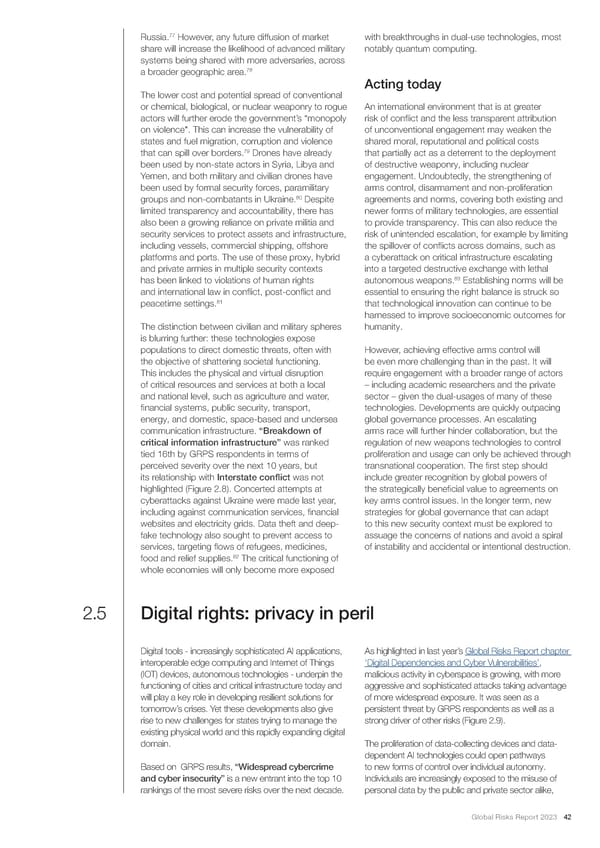77 Russia. However, any future diffusion of market with breakthroughs in dual-use technologies, most share will increase the likelihood of advanced military notably quantum computing. systems being shared with more adversaries, across 78 a broader geographic area. Acting today The lower cost and potential spread of conventional or chemical, biological, or nuclear weaponry to rogue An international environment that is at greater actors will further erode the government’s “monopoly risk of con昀氀ict and the less transparent attribution on violence". This can increase the vulnerability of of unconventional engagement may weaken the states and fuel migration, corruption and violence shared moral, reputational and political costs 79 that can spill over borders. Drones have already that partially act as a deterrent to the deployment been used by non-state actors in Syria, Libya and of destructive weaponry, including nuclear Yemen, and both military and civilian drones have engagement. Undoubtedly, the strengthening of been used by formal security forces, paramilitary arms control, disarmament and non-proliferation 80 groups and non-combatants in Ukraine. Despite agreements and norms, covering both existing and limited transparency and accountability, there has newer forms of military technologies, are essential also been a growing reliance on private militia and to provide transparency. This can also reduce the security services to protect assets and infrastructure, risk of unintended escalation, for example by limiting including vessels, commercial shipping, offshore the spillover of con昀氀icts across domains, such as platforms and ports. The use of these proxy, hybrid a cyberattack on critical infrastructure escalating and private armies in multiple security contexts into a targeted destructive exchange with lethal has been linked to violations of human rights autonomous weapons.83 Establishing norms will be and international law in con昀氀ict, post-con昀氀ict and essential to ensuring the right balance is struck so 81 peacetime settings. that technological innovation can continue to be harnessed to improve socioeconomic outcomes for The distinction between civilian and military spheres humanity. is blurring further: these technologies expose populations to direct domestic threats, often with However, achieving effective arms control will the objective of shattering societal functioning. be even more challenging than in the past. It will This includes the physical and virtual disruption require engagement with a broader range of actors of critical resources and services at both a local – including academic researchers and the private and national level, such as agriculture and water, sector – given the dual-usages of many of these 昀椀nancial systems, public security, transport, technologies. Developments are quickly outpacing energy, and domestic, space-based and undersea global governance processes. An escalating communication infrastructure. “Breakdown of arms race will further hinder collaboration, but the critical information infrastructure” was ranked regulation of new weapons technologies to control tied 16th by GRPS respondents in terms of proliferation and usage can only be achieved through perceived severity over the next 10 years, but transnational cooperation. The 昀椀rst step should its relationship with Interstate con昀氀ict was not include greater recognition by global powers of highlighted (Figure 2.8). Concerted attempts at the strategically bene昀椀cial value to agreements on cyberattacks against Ukraine were made last year, key arms control issues. In the longer term, new including against communication services, 昀椀nancial strategies for global governance that can adapt websites and electricity grids. Data theft and deep- to this new security context must be explored to fake technology also sought to prevent access to assuage the concerns of nations and avoid a spiral services, targeting 昀氀ows of refugees, medicines, of instability and accidental or intentional destruction. 82 food and relief supplies. The critical functioning of whole economies will only become more exposed 2.5 Digital rights: privacy in peril Digital tools - increasingly sophisticated AI applications, As highlighted in last year’s Global Risks Report chapter interoperable edge computing and Internet of Things ‘Digital Dependencies and Cyber Vulnerabilities’, (IOT) devices, autonomous technologies - underpin the malicious activity in cyberspace is growing, with more functioning of cities and critical infrastructure today and aggressive and sophisticated attacks taking advantage will play a key role in developing resilient solutions for of more widespread exposure. It was seen as a tomorrow’s crises. Yet these developments also give persistent threat by GRPS respondents as well as a rise to new challenges for states trying to manage the strong driver of other risks (Figure 2.9). existing physical world and this rapidly expanding digital domain. The proliferation of data-collecting devices and data- dependent AI technologies could open pathways Based on GRPS results, “Widespread cybercrime to new forms of control over individual autonomy. and cyber insecurity” is a new entrant into the top 10 Individuals are increasingly exposed to the misuse of rankings of the most severe risks over the next decade. personal data by the public and private sector alike, Global Risks Report 2023 42
 2023 | Global Risks Report Page 41 Page 43
2023 | Global Risks Report Page 41 Page 43